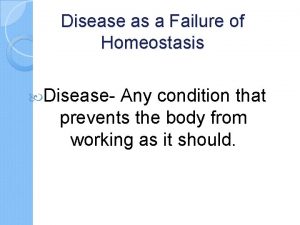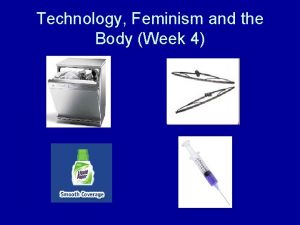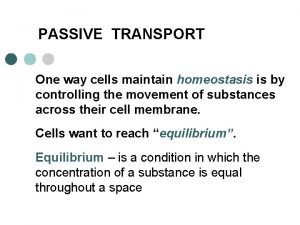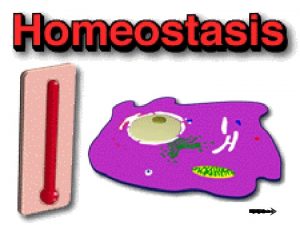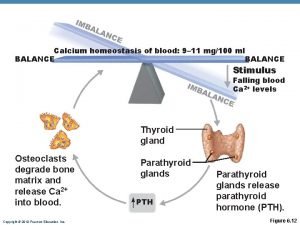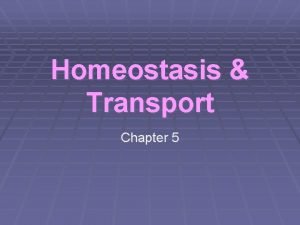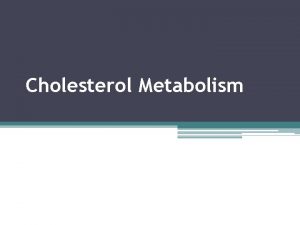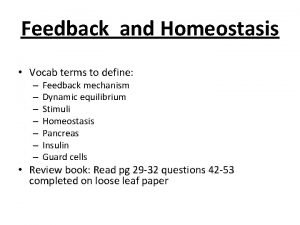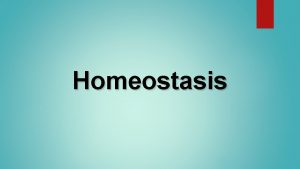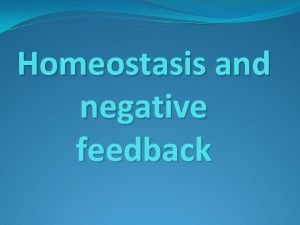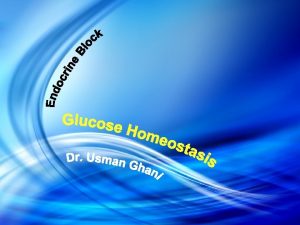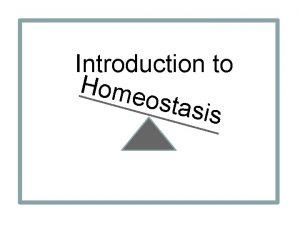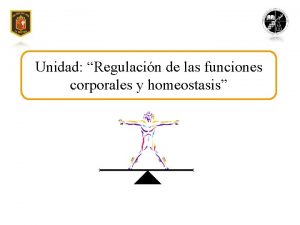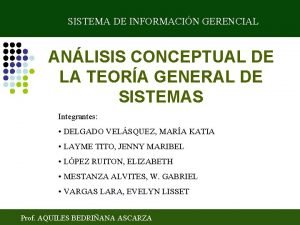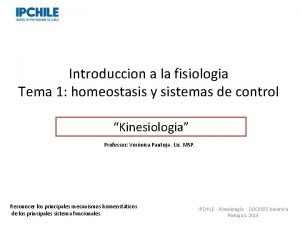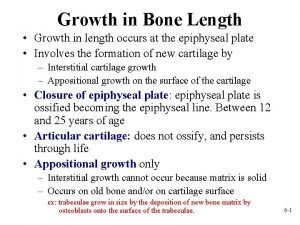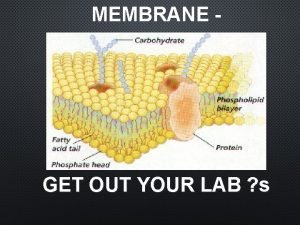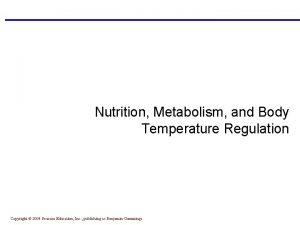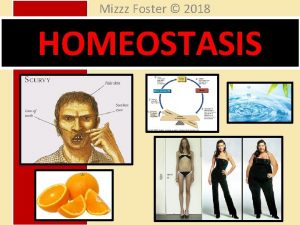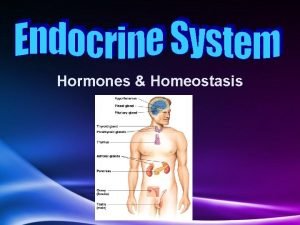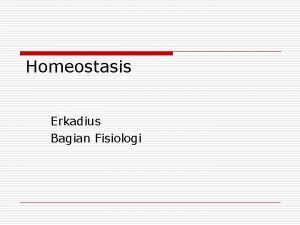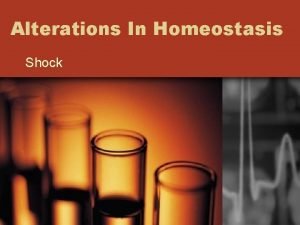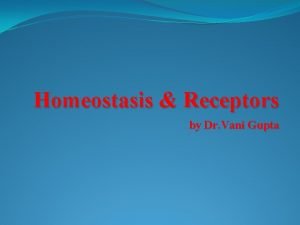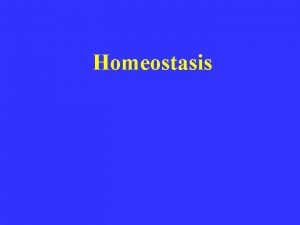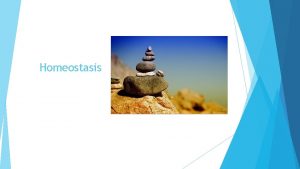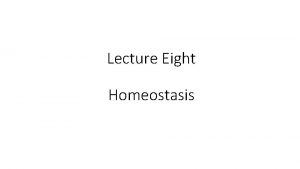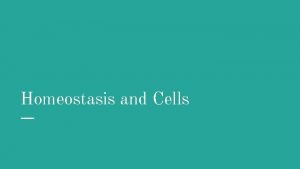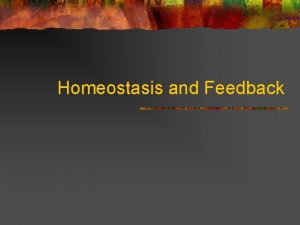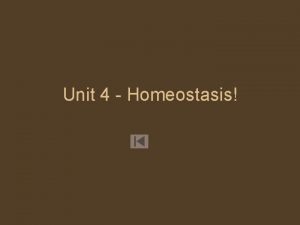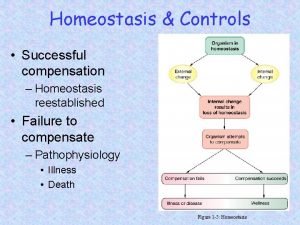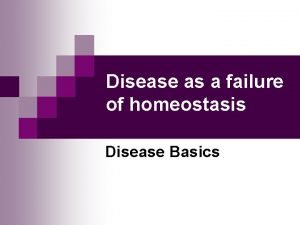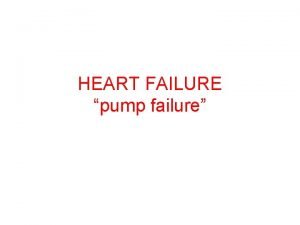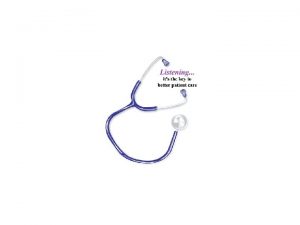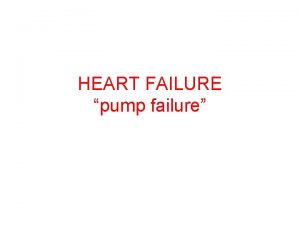Disease as a Failure of Homeostasis Disease Any


































- Slides: 34

Disease as a Failure of Homeostasis Disease- Any condition that prevents the body from working as it should.

Causes of Disease Pathogens- Foreign invader organisms that cause disease in plants and animals. Found in food, water, and air. Examples: Viruses Bacteria Fungi Parasites


Non Pathogenic Diseases Cancer- Genetic mutations resulting in uncontrolled cell division forming a tumor. ◦ Chemicals and radiation can increase mutations in genes. Ex. PCBs, dioxin, benzene, UV rays from the sun, x rays … others? ? ◦ If the immune system does not attack and destroy these cells, the disease may be life threatening

Non Pathogenic Diseases Causes of Non-Pathogenic diseases ◦ Inherited disease- Down’s Syndrome, cystic fibrosis, sickle cell anemia ◦ Toxins- lead poisoning, radiation poisoning ◦ High-risk behaviors- lung cancer, drug addiction, skin cancer ◦ Poor nutrition- scurvy (vitamin C deficiency), goiter (iodine deficiency) ◦ Organ malfunction- heart attack, diabetes

What is Immunity?

Immunity ◦ The ability of the body to fight infection and/or foreign invaders by producing antibodies or killing infected cells. Immune System ◦ The system in the body responsible for maintaining homeostasis by recognizing harmful from non harmful organisms and produces an appropriate response.

Foreign Invaders Called Pathogens ◦ Viruses, bacteria or other living that causes disease/immune response. Antigens- molecules on the outside of foreign cells or toxins that pathogens produce that cause harm to an organism.

Parts of the Immune System 1. 2. 3. 4. Blood - White Blood Cells in particular. Lymph nodes Thymus Gland – Produces T Lymphocytes Bone Marrow – Produces B Lymphocytes


How does the body fight infection/foreign invaders? The Body’s THREE lines of Defense First Line of Defense – The Skin • Provides Physical and Chemical barriers Physical – hard to penetrate, made of indigestible keratin Chemical – tears, sweat

Second Line of Defense – Nonspecific Immune Response These are defenses the body uses no matter what the invader may be. These defenses include: ◦ ◦ Phagocytosis – done by Macrophages Natural Cell Killers Inflammation - caused by release of Histamine from leukocytes Fever – The fever (high temp) kills invaders by denaturing their proteins. Macrophage: A phagocytic cell found in the liver, spleen, brain and lungs. Travels to all areas of the body to find and eat pathogens.


Third Line of Defense – Specific Immune Response This is a specific response to a specific pathogen/antigen. The response involves the creation of Antibodies.

Antibodies Y-shaped protein molecule. Made up of variable and constant regions. Made up of Heavy and Light chains. Produced by BLymphocytes Function: Recognize antigens, bind to and deactivate them. ◦ Note: Variable region recognizes the antigens.

How an antibody operates/works? Deactivation of a bacterium by an antibody.

The Pathway of Specific Immune Response Step 1 Pathogens eaten by Macrophage Step 2 Displays portion of Pathogen on surface Step 3 Pathogens Helper-T cell recognizes Pathogen

Activates B- Cell Activates Cytotoxic T- Cell Memory T-Cell Kills Infected Cells Memory B-Cell Antibodies

Cellular Immunity. vs. Antibody Immunity Cellular Immunity Carried out by T-Cells Infected cells are killed by Cytotoxic T –Cells. Cytotoxic T- cells squirt perforin, an enzyme that makes a hole in cell membranes of invaded cells. Water rushes in and the cell explodes!! Antibody or Humoral Immunity Carried out by B-cells Antibodies are produced and dumped into blood stream. Antibodies bind to antigens and deactivate them.

Immune Response Explained 1. 2. 3. 4. 5. 6. 7. 8. 9. 10. Antigen infects cells. Macrophage ingests antigen and displays portion on its surface. Helper T- Cell recognizes antigen on the surface of the macrophage and becomes active. Active Helper T-Cell activates Cytotoxic T-Cells and B-Cells. Cytotoxic T-Cells divide into Active Cytotoxic T-cells and Memory T – Cells. Active Cytotoxic T-Cells kill infected cells. At the same time, B-Cells divide into Plasma Cells and Memory B- Cells. Plasma cells produce antibodies that deactivate pathogen. Memory T and Memory B cells remain in the body to speed up the response if the same antigen reappears. Supressor T-Cells stop the immune response when all antigens have been destroyed.

Immune Response Summary Displays copy of antigen on surface of cell Antigen Macrophage Antibody Immunity Helper T - Cellular Immunity Active Cytotoxic T-Cell Kills Infected Cells Memory T- Cell Active B - Cell Plasma Cell Antibodies Deactivates Antigens Memory B-Cell

Primary. vs. Secondary Immune Response Primary Immune Response ◦ This is a response to an invader the First time the invader infects the body. No measurable immune response for first few days. Next 10 – 15 days antibody production grows steadily Secondary Immune Response ◦ A more rapid response to an invader the 2 nd time it invades the body. Antibody production increases dramatically and in a much shorter time period. .

Primary. vs. Secondary Immune Response

Passive. vs. Active Immunity 1. Active Immunity This is immunity where the body is “actively” producing antibodies to fight infection. Ex: You have a throat infection and you are actively creating antibodies to fight it. Vaccination: An injection of a dead or weakened strain of an infectious microbe (pathogen) that causes the body to undergo active immunity (produce antibodies). 2. Passive Immunity This is immunity where antibodies are given to a person from the blood of another person or animal. This immunity only lasts for a short period of time. ex: Breastfeeding mothers pass antibodies to their children through the milk.

Damage to the Immune System Age, stress, and viral diseases can weaken the immune system. In some cases the immune system is inappropriately over active. Sometimes the immune system becomes underactive.

Autoimmune Disease (over active) Autoimmune diseases are diseases where the immune system begins to attack itself. ◦ Ex: Rheumatoid Arthritis – crippling disease of the joints. Lupus – disease of blood and organs. Multiple Sclerosis – disease of nervous system Cause(s): unknown Cures/Treatments: No known cures. Usually treated with drugs.

Allergies- (over active) Allergy - An exaggerated response by the immune system to an allergen. Allergen: a normally harmless substance that causes an allergic reaction. ex: dust, pollen, mold, food, insect stings Types of Allergic reactions There are two types of allergic reactions. a. Immediate – occurs within seconds and normally lasts for about 30 mins. b. Delayed – takes longer to react and can last for a much longer time.

What happens during an allergic reaction? During an allergic reaction antibodies cause histamines to be released from certain cells. Histamines cause: a. Swelling of tissues b. Release of fluids (runny noses and eyes) c. muscle spasms (some cases) Anaphylaxis or anaphylactic shock: This is the sudden and severe allergic reaction to a substance that can cause death. Treatments for Allergies 1. Avoidance of material – especially food. 2. Epinephrine – “epi – pen” 3. Antihistamines – benadryl (combats allergy symptoms)


Rejection of Transplanted Organs (over active) The body recognizes foreign antigens on the newly transplanted organ and wages a war against the organ, killing it in a full force attack. ◦ Tissue matching is done to ensure that the tissues transplanted are genetically as close as possible to the host. ◦ Anti-rejection drugs are given, but these make the person’s immune system weaker

AIDS (underactive) HIV attacks white blood cells, most importantly the helper T cells. The body is unable to activate cytotoxic T cells or B cells and so the body is unable to effectively fight disease. The person dies of “opportunistic diseases” that they would not have died of had they had a healthy immune system.

HIV LIFE CYCLE

Research and Progress Against Disease How do we diagnose disease? X-rays, CAT scans, ultrasounds, culturing bacteria, blood pressure monitoring devices, genetic testing ● How do we prevent and control disease? - - Promote sanitation, frequent hand washing, proper garbage disposal, and sewage treatment. Sterilize surgical instruments, treat wounds with antiseptic. Control populations of rats, flies and other vermin. Treat water and milk to reduce pathogens in them. Vaccinate! Educate about the dangers of risky behaviors.

Research and Progress Against Disease How do we treat and cure disease? ◦ Developed antibiotics and other drugs to kill pathogens ◦ Developed medical procedures, including surgical procedures and laser techniques to remove damaged or diseased tissues from the body.
 Bioflix activity homeostasis low blood glucose
Bioflix activity homeostasis low blood glucose Bioflix activity homeostasis high blood glucose
Bioflix activity homeostasis high blood glucose Failure of homeostasis
Failure of homeostasis Ductile fracture surface
Ductile fracture surface Ventricular escape rhythm
Ventricular escape rhythm Failure to capture vs failure to sense
Failure to capture vs failure to sense There is some cake
There is some cake Any to any connectivity
Any to any connectivity Pertanyaan terbuka
Pertanyaan terbuka Bharathi viswanathan
Bharathi viswanathan Give an example of homeostasis.
Give an example of homeostasis. Feminine homeostasis technology
Feminine homeostasis technology One way cells maintain homeostasis is by controlling
One way cells maintain homeostasis is by controlling Homeostasis importance
Homeostasis importance Homeostasis animals
Homeostasis animals Drive-reduction theory
Drive-reduction theory Homeostasis blood calcium level (about 10 mg/100ml)
Homeostasis blood calcium level (about 10 mg/100ml) Homeostasis adalah
Homeostasis adalah Section 5-2 review active transport
Section 5-2 review active transport Homeostasis examples
Homeostasis examples Cholesterol homeostasis
Cholesterol homeostasis Positive feedback
Positive feedback Importance of homeostasis in mammals
Importance of homeostasis in mammals Homeostasis
Homeostasis Homeostasis worksheet
Homeostasis worksheet Negative feedback homeostasis examples
Negative feedback homeostasis examples Homeostasis definition ap psychology
Homeostasis definition ap psychology 5 phases of glucose homeostasis
5 phases of glucose homeostasis What is homeostas
What is homeostas Imágenes de la homeostasis
Imágenes de la homeostasis ¿qué es la homeostasis y ejemplos
¿qué es la homeostasis y ejemplos Introduccion de homeostasis
Introduccion de homeostasis Epiphyseal cartilage
Epiphyseal cartilage Plants cells _________ water and start to _w_ ___ ___ ___.
Plants cells _________ water and start to _w_ ___ ___ ___. Temperature regulation
Temperature regulation


